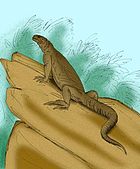Limnoscansor
| Limnoscansor | |
|---|---|

| |
| The holotype of Limnoscansor (left), and a close-up of the skull (right) | |
| Scientific classification | |
| Domain: | Eukaryota |
| Kingdom: | Animalia |
| Phylum: | Chordata |
| Class: | Reptilia |
| Order: | Squamata |
| Family: | †Ardeosauridae |
| Genus: | †Limnoscansor Meyer et al., 2023 |
| Type species | |
| †Homeosaurus digitatellus Grier, 1914 | |
| Species | |
| |
| Synonyms | |
| |
Limnoscansor (/ˌlɪm͡nəuskɑːnsʊr/) is a prehistoric genus of ardeosaurid lizard from the Late Jurassic Solnhofen Limestone of Germany.[1]
Discovery and naming

The holotype, and only known specimen of Limnoscansor, given the designation CM 4026, was discovered at a place called Wintershof Quarry, near Eichstätt in the rocks of the Solnhofen Limestone — a geological unit that is well-known for exceptional preservation of small animals.[2][3] It was originally named and described by Normal MacDowell Grier in the Annals of the Carnegie Museum of Natural History in 1914. In this publication, Grier named it as a new species of the rhynchocephalian Homeosaurus, which is known from Solnhofen as well as other Jurassic-aged units. He gave it the species epithet, "digitatellus", in reference to the apparently fragile digits of the specimen, which appear to have been damaged some time after the animal died, but before it was fossilized.[4]
Upon re-examination in 1963, the French paleontologist Marguerite Cocude-Michel realized that CM 4026 did not belong to a rhynchocephalian at all, and instead represented a species of squamate, related to modern geckos. He referred the specimen to the genus Eichstaettisaurus, which was discovered at the same locality as CM 4026.[5] The next year, another French researcher, Robert Hoffstetter, reassigned the specimen to the genus Ardeosaurus.[1]
The newly reassigned Ardeosaurus digitatellus was given a detailed modern description in a publication in 2016 by several researchers from the University of Alberta including Tiago Simões, Michael Caldwell, Randall Nydam, and Paulina Jiménez-Huidobro. A few years later, in 2023, the specimen was re-examined by a team of authors including Dalton Meyer, Chase Brownstein, Kelsey Jenkins, and Jacques Gauthier. In their phylogenetic analysis, they failed to recover the genus Ardeosaurus as monophyletic, and so they elected to assign A. digitatellus to its own genus in order to prevent future taxonomic instability from making its classification even more convoluted. They named this new genus Limnoscansor, which is derived from the Ancient Greek word "limnes", meaning "lake" or "marsh", in reference to the paleoenvironment of the Solnhofen Limestone, and the Latin word "scansorius", meaning "to climb", in reference to its hypothesized climbing abilities.[1]
Description
The holotype, and only specimen, of Limnoscansor is a nearly complete skull and postcranial skeleton preserved fully articulated in dorsal view. The specimen is only lacking the hands and the posterior portion of the tail.[4]
Classification

In their description of Limnoscansor, Meyer and colleagues conducted a phylogenetic analysis to determine the evolutionary relationships of the new taxon. They found it to be a member of the family Ardeosauridae, and suggested that this family was a stem-member of Gekkota. The affinities of Ardeosauridae are generally controversial among researchers. A simplified version of the phylogeny recovered by the authors is shown below.[1]
| Pan‑Gekkota |
| ||||||||||||
Paleoenvironment
Other small reptiles are known from the Wintershof Quarry including the closely related squamates Ardeosaurus and Eichstaettisaurus, the rhynchocephalian Pleurosaurus, the crocodyliform Alligatorellus, and the pterosaur Ctenochasma. The locality also preserves a variety of insect fossils including scorpionflies, dragonflies, and stem-dragonflies.[3]
References
- ^ a b c d Meyer, Dalton; Brownstein, Chase D.; Jenkins, Kelsey M.; Gauthier, Jacques A. (2023). "A Morrison stem gekkotan reveals gecko evolution and Jurassic biogeography". Proceedings of the Royal Society B: Biological Sciences. 290 (2011). doi:10.1098/rspb.2023.2284. PMC 10685121.
- ^ Simões, Tiago R.; Caldwell, Michael W.; Nydam, Randall L.; Jiménez-Huidobro, Paulina (2016). "Osteology, phylogeny, and functional morphology of two Jurassic lizard species and the early evolution of scansoriality in geckoes". Zoological Journal of the Linnean Society. doi:10.1111/zoj.12487.
- ^ a b Clapham, Matthew (2011). "Wintershof Quarry, Eichstätt, Solnhofen (Jurassic of Germany)". The Paleobiology Database.
- ^ a b Grier N. 1914. A new rhynchocephalian from the Jura of Solenhofen. Ann Carnegie Mus 9, 86–90.
- ^ Cocude-Michel, Marguerite (1963). "Les rhynchocéphales et les sauriens des calcaires lithographiques (Jurassique supérieur) d'Europe occidentale". Nouvelles Archives du Muséum d'Histoire Naturelle de Lyon. 7: 3–224. doi:10.3406/mhnly.1963.992.





